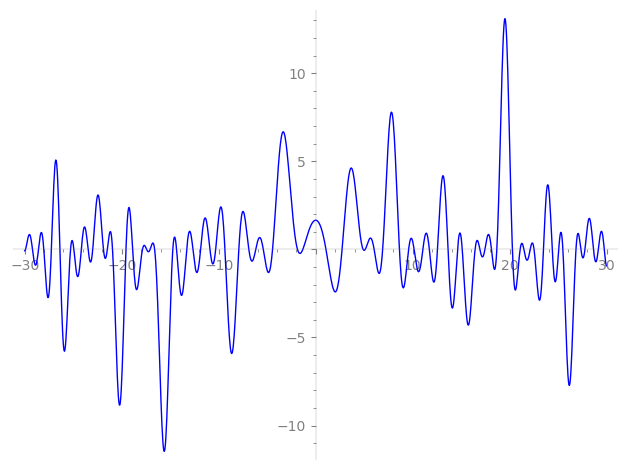| L(s) = 1 | + (−4.36 − 2.51i)3-s + 8.41·5-s + (7.34 − 4.23i)7-s + (8.18 + 14.1i)9-s + (7.71 + 4.45i)11-s + (−10.0 + 8.26i)13-s + (−36.7 − 21.2i)15-s + (15.0 + 26.0i)17-s + (−14.7 + 8.50i)19-s − 42.7·21-s + (24.9 + 14.4i)23-s + 45.8·25-s − 37.1i·27-s + (13.5 − 23.5i)29-s + 14.5i·31-s + ⋯ |
| L(s) = 1 | + (−1.45 − 0.839i)3-s + 1.68·5-s + (1.04 − 0.605i)7-s + (0.909 + 1.57i)9-s + (0.701 + 0.404i)11-s + (−0.771 + 0.636i)13-s + (−2.44 − 1.41i)15-s + (0.885 + 1.53i)17-s + (−0.775 + 0.447i)19-s − 2.03·21-s + (1.08 + 0.626i)23-s + 1.83·25-s − 1.37i·27-s + (0.467 − 0.810i)29-s + 0.470i·31-s + ⋯ |
\[\begin{aligned}\Lambda(s)=\mathstrut & 416 ^{s/2} \, \Gamma_{\C}(s) \, L(s)\cr =\mathstrut & (0.934 + 0.356i)\, \overline{\Lambda}(3-s) \end{aligned}\]
\[\begin{aligned}\Lambda(s)=\mathstrut & 416 ^{s/2} \, \Gamma_{\C}(s+1) \, L(s)\cr =\mathstrut & (0.934 + 0.356i)\, \overline{\Lambda}(1-s) \end{aligned}\]
Particular Values
| \(L(\frac{3}{2})\) |
\(\approx\) |
\(1.62887 - 0.299917i\) |
| \(L(\frac12)\) |
\(\approx\) |
\(1.62887 - 0.299917i\) |
| \(L(2)\) |
|
not available |
| \(L(1)\) |
|
not available |
\(L(s) = \displaystyle \prod_{p} F_p(p^{-s})^{-1} \)
| $p$ | $F_p(T)$ |
|---|
| bad | 2 | \( 1 \) |
| 13 | \( 1 + (10.0 - 8.26i)T \) |
| good | 3 | \( 1 + (4.36 + 2.51i)T + (4.5 + 7.79i)T^{2} \) |
| 5 | \( 1 - 8.41T + 25T^{2} \) |
| 7 | \( 1 + (-7.34 + 4.23i)T + (24.5 - 42.4i)T^{2} \) |
| 11 | \( 1 + (-7.71 - 4.45i)T + (60.5 + 104. i)T^{2} \) |
| 17 | \( 1 + (-15.0 - 26.0i)T + (-144.5 + 250. i)T^{2} \) |
| 19 | \( 1 + (14.7 - 8.50i)T + (180.5 - 312. i)T^{2} \) |
| 23 | \( 1 + (-24.9 - 14.4i)T + (264.5 + 458. i)T^{2} \) |
| 29 | \( 1 + (-13.5 + 23.5i)T + (-420.5 - 728. i)T^{2} \) |
| 31 | \( 1 - 14.5iT - 961T^{2} \) |
| 37 | \( 1 + (-29.6 + 51.4i)T + (-684.5 - 1.18e3i)T^{2} \) |
| 41 | \( 1 + (-7.86 + 13.6i)T + (-840.5 - 1.45e3i)T^{2} \) |
| 43 | \( 1 + (49.0 - 28.3i)T + (924.5 - 1.60e3i)T^{2} \) |
| 47 | \( 1 - 7.91iT - 2.20e3T^{2} \) |
| 53 | \( 1 + 16.2T + 2.80e3T^{2} \) |
| 59 | \( 1 + (-21.4 + 12.3i)T + (1.74e3 - 3.01e3i)T^{2} \) |
| 61 | \( 1 + (10.9 + 18.8i)T + (-1.86e3 + 3.22e3i)T^{2} \) |
| 67 | \( 1 + (15.2 + 8.77i)T + (2.24e3 + 3.88e3i)T^{2} \) |
| 71 | \( 1 + (-4.68 + 2.70i)T + (2.52e3 - 4.36e3i)T^{2} \) |
| 73 | \( 1 + 15.4T + 5.32e3T^{2} \) |
| 79 | \( 1 + 118. iT - 6.24e3T^{2} \) |
| 83 | \( 1 - 23.0iT - 6.88e3T^{2} \) |
| 89 | \( 1 + (0.627 - 1.08i)T + (-3.96e3 - 6.85e3i)T^{2} \) |
| 97 | \( 1 + (24.0 + 41.6i)T + (-4.70e3 + 8.14e3i)T^{2} \) |
| show more | |
| show less | |
\(L(s) = \displaystyle\prod_p \ \prod_{j=1}^{2} (1 - \alpha_{j,p}\, p^{-s})^{-1}\)
Imaginary part of the first few zeros on the critical line
−10.90283141551425198046713884424, −10.31339799706093381794543431850, −9.360494655575306787249067793622, −7.927001849285525668599468654241, −6.89466506898019022240263902753, −6.18226298580212394699894823359, −5.40438018180950481481194148909, −4.45026503610263704542131838926, −1.88121309814010093187210918857, −1.32927820278625342764846107962,
1.05557340810766305559871267547, 2.71617620369132310814193146513, 4.88715830109036507255290718786, 5.10301688219360995266147068096, 6.01964062408961375504567509267, 6.89933036233223971036361430181, 8.629273231588039795863910048637, 9.574198587868617690933676048709, 10.13976833671077250774196485195, 11.04466867986197873092501607802

